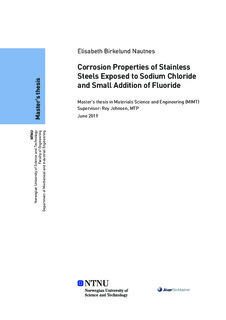| dc.contributor.advisor | Johnsen, Roy | |
| dc.contributor.author | Nautnes, Elisabeth Birkelund | |
| dc.date.accessioned | 2019-10-18T14:02:49Z | |
| dc.date.available | 2019-10-18T14:02:49Z | |
| dc.date.issued | 2019 | |
| dc.identifier.uri | http://hdl.handle.net/11250/2623211 | |
| dc.description.abstract | Formålet med denne oppgaven var å undersøke hvilken effekt fluorider og klorider har på gropkorrosjon av ulike rustfrie stål. Denne rapporten vurderer kritiske faktorer som temperatur kombinert med ulik konsentrasjon av NaF og NaCl ved rom temperatur, 60 0C og 95 0C.
Grundig litteraturstudie av tidligere forsøk relatert til korrosjon ved høye temperaturer og tilstedeværelse av klorider og fluorider er utført, og forsøkt knyttet opp mot det aktuelle miljøet i dette studiet. Cyclic potentiodynamic polarization (CPP) tester i henhold til ASTM G-61 ble gjennomført for å bestemme effekten av temperatur og tilsetning av NaF i en kloridholdig løsning på korrosjonsmotstand. Måling av åpen krets potensial (OCP) ble også undersøkt. OCP ble sammenlignet med grop korrosjons- og repassiveringspotensialet hentet fra CPP testene for evaluering av materialenes motstand mot gropkorrosjon. Karakterisering av overflater ved bruk av Infinite Focus Mikroskop (IFM), Secondary Electron Mikroskop (SEM) and Energy Dispersive Spectroscopy (EDS) ble gjennomført for å undersøke effekten av fluorider på gropkorrosjon.
Resultatene fra det eksperimentelle arbeidet viser at effekten av NaF øker grop korrosjonspotensialet sammenlignet med løsninger med kun NaCl. Grop korrosjonspotensialet øker også med økt konsentrasjon av NaF i mikset løsninger av NaF og NaCl. Effekten av fluorider i løsninger som inneholder både NaF og NaCl øker den passive strøm tettheten. Dette forklares ved at ioneradiusen av fluorider, som er minst blant halogen ionene, og kan forårsake raskere penetrering. Dybden på gropkorrosjon økte med økt konsentrasjon av NaF.
Alle materialene som ble testet i dette studiet er vurdert til å ikke være utsatt for gropkorrosjon ved 95 0C. Dette er vurdert på grunnlag av OCP målingene hvor materialene hadde grop korrosjonspotensial mer nobelt enn OCP. Basert på litteraturundersøkelsene vil støpt duplex rustfritt stål UNS J93371 være utsatt for gropkorrosjon på grunnlag av at 95 0C ligger over CPT. En løsning for Aker Biomarines korrosjonsproblem kan være å bytte materialet til super duplex rustfritt stål (SDSS) UNS J93404. Det vil uansett være viktig å foreta videre undersøkelser for støpte materialer. | |
| dc.description.abstract | The purpose of this thesis has been to examine the effect of fluoride and chloride on pitting corrosion of different stainless steels. This study considers critical factors as temperature combined with different concentrations of NaF and NaCl at room temperature, 60 0C and 95 0C.
A thorough literature survey on prior experiments related to corrosion at high temperatures and the presence of chloride- and fluoride ions has been made and attempted to be linked to the actual environment in this study. Cyclic potentiodynamic polarization (CPP) tests according to ASTM G-61 were conducted to determine the effect of temperature and the addition of NaF into a chloride bearing solution on pitting corrosion resistance. Open circuit potential (OCP) measurement were also examined. OCP was compared with pitting potential and repassivating potential obtained from CPP tests for evaluating the materials resistance against pitting corrosion. Surface characterization using Infinite Focus Microscopy (IFM), Secondary Electron Microscopy (SEM) and Energy Dispersive Spectroscopy (EDS) were performed to investigate the effect of fluoride on pitting corrosion.
The results from the experimental work show that the effect of NaF increases the pitting potential compared with sole NaCl solutions. Pitting potential also increases with increased concentration of NaF in mixed solutions of NaF and NaCl. The effect of fluoride in mixed solutions of NaF and NaCl increases the passive current density. This is explained by the ionic radius of fluoride, which is the smallest of the halogen ions, and might cause faster penetration. However, the depth of the pitting corrosion increased with higher concentration of NaF.
All of the materials tested in this study were considered to withstand pitting corrosion at 95 0C. This was assessed on the basis of OCP measurements where the materials obtained pitting potential more noble than OCP. However, based on the literature survey the cast duplex stainless steel UNS J93371 is vulnerable to pitting corrosion due to 95 0C which is above the CPT. A solution to Aker Biomarines corrosion problem could be to replace the material to super duplex stainless steel (SDSS) UNS J93404. Further testing is recommended of cast alloys. | |
| dc.language | eng | |
| dc.publisher | NTNU | |
| dc.title | Corrosion Properties of Stainless Steels Exposed to Sodium Chloride and Small Addition of Fluoride | |
| dc.type | Master thesis | |
